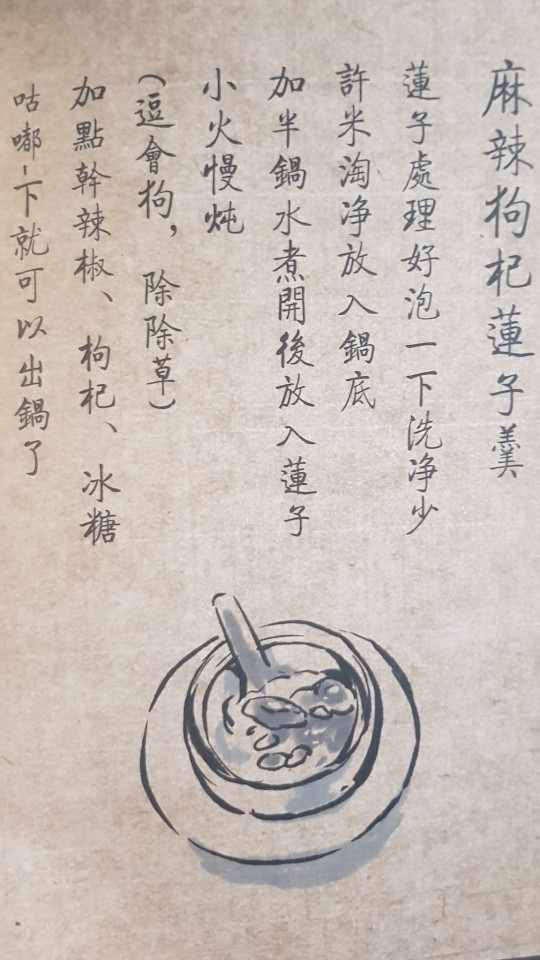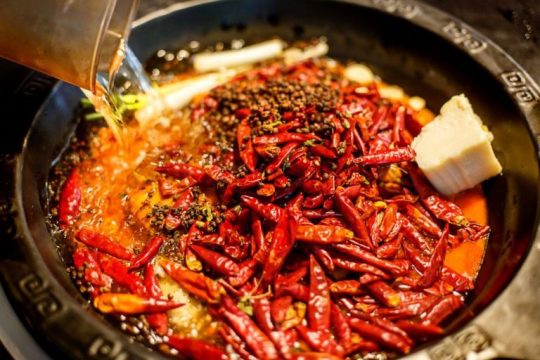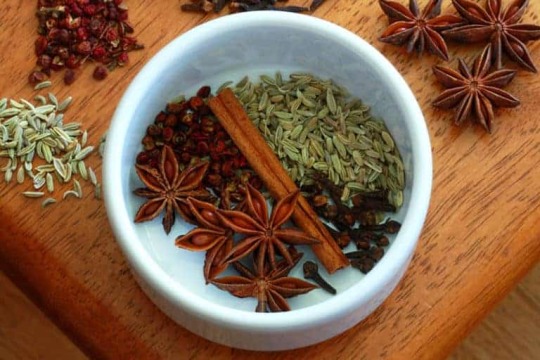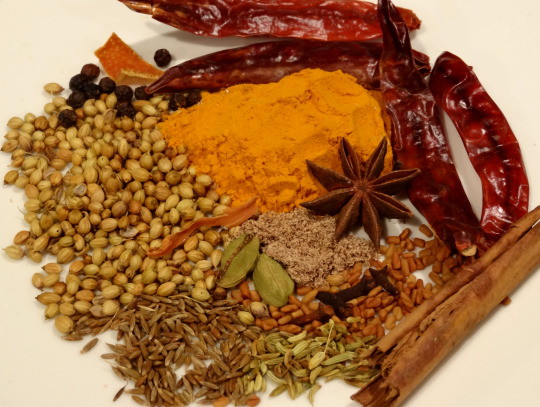#sichuan chili peppers
Text

Kung Pao Cauliflower / 宫保菜花 (Vegan)
#vegan#appetizer#lunch#dinner#veganized#kung pao chicken#chinese cuisine#east asian cuisine#cauliflower chicken#cauliflower#bell peppers#green onion#peanuts#plant milk#sesame oil#cornstarch#vinegar#soy sauce#sichuan peppercorns#chili#ginger#garlic#coconut sugar
76 notes
·
View notes
Text
#brownie mix#gochugaru#sichuan chili flakes#aleppo pepper flakes#light brown sugar#chopped nuts#cream cheese#tahini#chili crisp#spicy sweet#sweet and spicy#brownies
0 notes
Text
Sichuan Pork Ragu
Via Lucky Peach.
2 tbsp neutral oil
2 large yellow onions, halved and thinly sliced (about 5 cups)
1 lb ground pork
1 tbsp chopped garlic
2 tbsp doubanjiang or gochujang (spicy chili-bean paste)
1 tbsp sichuan peppercorns
1 tsp chili flakes (preferably gochugaru)
1 tbsp soy sauce
1 tbsp sugar
1/4 cup water
kosher salt
2 cups coarseley chopped bok choy (I used what I had at home – snap…

View On WordPress
0 notes
Text
Los secretos detrás del picante de Sichuan
Los secretos detrás del picante de Sichuan

La comida de Sichuan, una de las cocinas más populares de las ocho cocinas de China, goza ahora de una gran popularidad en todo el mundo. Esta comida es famosa por su sabor picante y entumecedor y no para de sorprender por sus combinaciones, originalidad y explosión de sabores. Pero este sabor no se hace solo, hacen falta ingredientes, condimentos, sabores, materiales…
En este artículo te enseñamos los secretos que hay detrás del picante de esta cocina tan apreciada. ¿Te atreverás a introducirlos en tus recetas?
Condimentos
Aquí viene lo fuerte. Son preparaciones que se realizan a priori para posteriormente introducirlas en recetas y platos: doubanjiang, dou-chi, chili peppers, pimienta de Sichuan, aceite de chile, aromas y especias.

Doubanjiang
Doubanjiang es un tipo de pasta de habas fermentadas que se usa comúnmente en la cocina de Sichuan. Tiene un sabor fuerte y salado y se usa como aderezo o condimento en muchos platos. Se define a menudo como «el alma de la comida de Sichuan». La mitad de los mejores platos de Sichuan usan doubanjiang para construir el sabor base. Además, el doubanjiang puede darle al plato un hermoso color rojo brillante.
Si quieres usarlo para tus recetas, se puede encontrar doubanjiang ya preparado en botes.
Dou-chi
El dou-chi es un tipo de soja negra fermentada que se usa como condimento en la cocina de Sichuan. Tiene un sabor fuerte y terroso y se usa con moderación en los platos debido a su alto contenido de sal.
Chili peppers
Los chiles se usan mucho en la cocina de Sichuan, tanto frescos como secos. Agregan un calor ardiente característico a los platos, así como una profundidad de sabor.
Pimienta de Sichuan (Hua Jiao)
La pimienta de Sichuan o el grano de pimienta de Sichuan es otro ingrediente clave en muchos platos de Sichuan. Tiene un sabor único que es ligeramente cítrico y floral, con un toque picante y una fuerte sensación de adormecimiento en la lengua.
Aceite de chile
Si te encanta la comida de Sichuan, no hay motivo para perderse el aceite de chile. Es una salsa de chile hecha con aceite vegetal (localmente se usa aceite de colza), aromáticos (jengibre y cebolla), hojuelas de chile frito de Sichuan y especias. El aceite de chile de Sichuan es un ingrediente ideal para ensaladas o fideos. Muchos restaurantes lo utilizan como condimento de mesa que se puede añadir a todo.
Aromas y especias
Los aromas (jengibre, ajo y cebolla verde) también se usan para agregar profundidad de sabor a los platos de Sichuan. Estos ingredientes se utilizan a menudo junto con los chiles y la pimienta de Sichuan para crear platos complejos y sabrosos.
Sabores
Para conseguir esta explosión de sabores picantes, hace falta sabor, y esto se consigue introduciendo en las recetas los diferentes sabores de Sichuan. Aquí tienes unos cuantos.
Sabor Salsa mala
El sabor de la salsa mala es solo un aspecto de la cocina de Sichuan. Pero este sabor es el más exitoso. Personalmente, nos encanta mucho este sabor. El grano de pimienta de Sichuan juega un papel fundamental en este sabor. Crea una sensación de adormecimiento y hace que nuestro sistema gustativo sea mucho más sensible. Es por eso que sueles ser aditivo.
Sabor Yu Xiang
El sabor Yu Xiang es otro sabor popular fuera de China. La salsa Yu Xiang a menudo se conoce como salsa picante de ajo. Un ejemplo famoso donde se usa este sabor es la berenjena de Sichuan, o Yu Xiang Qie Zi (鱼香茄子 en chino). «鱼香» en realidad significa pescado fragante, es un tipo de sabor que es bastante famoso en los platos de Sichuan. Algunos menús pueden referirse a este plato como berenjenas en salsa china de ajo picante. Está hecho con una variedad de ingredientes que incluyen chiles, ajo, jengibre, cebollín y salsa de soya. La salsa se usa a menudo como salsa combinada para saltear o como salsa para mojar.
Sabor agridulce
El sabor agridulce es uno de los sabores más comunes en la cocina china. Pero la cocina de Sichuan también tiene su propia versión de sabor agridulce. El sabor agridulce en Sichuan difiere de otras zona. No solo es picante y amargo, sino que, en la mayoría de los casos, tiene un fuerte sabor a pimienta de Sichuan. Un plato clásico que representa este sabor son las patatas ralladas agridulces en las que también se pone el grano de pimienta de Sichuan para crear un sabor con más capas.
Sabor guai wei
El sabor extraño (guai wei) es un sabor difícil de encontrar en otras cocinas chinas. Creo que la mayoría de vosotros no conocéis este sabor. Está hecho con ingredientes comunes, salsa de soya, azúcar, aromáticos y chiles, a veces granos de pimienta de Sichuan. Pero la proporción es diferente de los sabores anteriores y, por lo tanto, crea un sabor que es difícil de describir. Por eso se llama sabor fuerte. La berenjena crujiente salada lleva este sabor.
Sabor Hula
Se define como sabor chile quemado (sabor Hula). Este es un sabor que se debe a la técnica para obtenerlo. Los chiles u otras especias secas se fríen en un wok hasta que se oscurezcan. Entonces, el aceite absorbe profundamente los sabores de los pimientos, luego se agregan más ingredientes para mezclarlos con el aceite. También se pueden agregar otras salsas y condimentos para realzar el sabor. El ejemplo más representativo es el bok choy salteado con ajo y chile. Pero el sabor de la guindilla es solo un tono fundamental. Esta salsa se verá realzada por los sabores del grano de pimienta de Sichuan, el vinagre negro y el azúcar. El sabor Kung Pao es un subtipo del sabor.
Sabor salsa de ajo
El sabor a salsa de ajo se usa principalmente en platos fríos y ensaladas. Se utiliza una gran cantidad de ajo para solidificar la base. Esta salsa suele contener un sabor de muy tenue a dulce y se suele añadir aceite de chile.
Sabor a pasta de sésamo
El sabor a pasta de sésamo utiliza pasta de sésamo como base principal, y la salsa de soja, el aceite de sésamo, la sal y el azúcar son añadidos. La pasta de sésamo tiene un sabor muy fuerte, por lo que hay que limitarse a una pequeña cantidad en las recetas. Este sabor es muy bueno para verduras y fideos.
Sabor a pimienta de Sichuan y cebolla verde
El sabor a pimienta de Sichuan y cebolla verde (椒麻味) es muy exclusivo de la comida de Sichuan y es casi desconocido fuera de China. Este sabor se hace simplemente con pimienta de Sichuan, cebolla verde y aceite de sésamo. Esos tres condimentos crean deliciosos sabores que pueden superar los sabores de una larga lista.
#Aceite de chile#Aromáticos y especias#Chili peppers#cocina sichuan#Dou-chi#Doubanjiang#Hua Jiao#Pimienta de Sichuan#Sabor a pasta de sésamo#Sabor a pimienta de Sichuan y cebolla verde#Sabor agridulce#Sabor Hula#Sabor salsa de ajo#salsa mala#secretos recetas sichuan#Yu Xiang
0 notes
Text
Mysterious Lotus Casebook 蓮花樓
Spicy goji and lotus seed soup
麻辣枸杞蓮子羹
Recipe from the official drama artbook

Prepare the lotus seeds* let it soak in water a little. Wash some rice** and put it in the pot covered with water up to half the pot, add the lotus seeds when the water is boiling. Let it stew on low heat. (Play with the dog a bit, weed the plants some) Add some dry chili, goji berries and rock sugar. Gulu*** a little and it's ready!

Personal Notes:
*I you use dry seeds, soak in water for the night, save the fragrant water for the soup, open the seeds to remove the sprout otherwise it will give a very bitter taste to your dish.
**just a handful, or it won't be a soup. I'd suggest using glutinous rice, it taste better for sweet soups, or at least round rice ("sushi rice")
***when it's boiling again
- Traditional Chinese Medicine would recommend serving this hot but it should be tasty as a cold treat as well.
- The title says 麻辣 so it implies the use of sichuan/mala pepper 花椒. You can try if you enjoy the taste. (I personally dislike it and that's my main issue with ShìChuan cuisine, I can't have the 辣🌶 without the abundance of 麻.)
- If you don't trust HuaHua's bìchá-poison-damaged eyesight "creativity", replace the chili with dry red date/jujube 紅棗 to make this dish more traditional.
109 notes
·
View notes
Text

[ID: A sandwich on a ciabatta roll; a plate of tomato sliced and a glass of mint lemonade are in the background. End ID]
Tofu sandwich with garlic-lemon sauce
A sweet, savory, and well-spiced glaze clinging to fried, crispy tofu. The zest and brightness of garlic-lemon mayonnaise complement the depth of the glaze. A great breakfast sandwich or weekend lunch option when eaten with your choice of bread and toppings.
Recipe under the cut!
Patreon | Tip jar
Ingredients:
For the sandwiches:
4 ciabatta rolls, or other bread
Bean sprouts or other greens
For the tofu:
1 block (350g) extra firm tofu
2-3 Tbsp potato starch, or cornstarch
Oil to fry
For the tofu slurry:
2 scallions, sliced (optional)
2 Tbsp toasted sesame oil, or olive oil
2 Tbsp soy sauce
2 Tbsp light soy sauce
1/2 Tbsp light brown sugar
1 tsp sriracha or chili garlic sauce
1/2 tsp garlic powder
1/2 tsp onion powder
1/2 tsp Sichuan pepper
Pinch ground fennel
Pinch ground sumac
Pinch ground cubeb pepper (Piper cubeba; kabab chini; كبابة صينى)
Pinch smoked paprika
1 Tbsp cornstarch
Cubeb berries may be found in the spice section of a south Asian grocery store, where they will be labelled "kabab chini." They are sometimes mistaken for allspice, but cubeb berries are smaller and more consistent in size, are darker in color, and have a slightly 'wrinkled' appearance. They have a pungent, camphorous, and sharp aroma. If you don't have any, you may replace them with equal parts black pepper and allspice; or a pinch of ground Indian black cardamom.
For the garlic mayo:
1/4 cup vegan mayonnaise
1 large clove garlic, grated
1 tsp lemon juice
1/4 tsp table salt
1/4 tsp black pepper
Water, if necessary
Instructions:
For the garlic mayo:
1. Mix all ingredients except water in a small mixing bowl. Add water or lemon juice until desired consistency is achieved. Taste and adjust salt and pepper.
For the marinade:
1. Pulverise scallion with salt in a mortar and pestle, and mix with other ingredients; or add all ingredients to a blender and combine.
For the tofu:
1. Drain tofu, wrap in a kitchen towel, and press under a flat, heavy object for 20-30 minutes.
2. If your block of tofu is particularly thick, slice it into two thinner slabs; then halve it widthwise to make four pieces. The tofu in the photo has only been halved widthwise to make two, thicker pieces.
3. Coat tofu in potato starch or cornstarch.
4. Heat 1/2" (1cm) of a neutral oil in a skillet on medium. Fry tofu slices, flipping once, until golden brown and crispy on both sides. Set aside.
5. Heat a large skillet over medium-high heat (or remove the oil from the one you used earlier). Add tofu and marinade and cook, pushing the marinade onto the tofu slices and flipping occasionally, until marinade is clinging to the tofu.
To assemble:
1. Add cooked tofu to sandwiches along with greens, tomatoes, avocado, or sliced onion as desired. Top with garlic mayo.
123 notes
·
View notes
Text
Today I learned Sichuan pepper is not a peppercorn nor a chili but the fruit of a shrub in the citrus and rue family. It is so closely related to citrus that they can pass pathogens between each other.
180 notes
·
View notes
Text
Compound behind Sichuan pepper


Zanthoxylum bungeanum is a species of plant in the family Rutaceae. It is one of the sources of the spice Sichuan pepper. Sichuan pepper, originally from the Himalayas in China, is one of the oldest spices in the country.
Zanthoxylum contains limonene, geranyl, isanisole, cresine, and other volatile substances, so it has a strong aroma. The most unique spicy taste of Sichuan pepper is brought by "Hydroxy-α-sanshool", which will make people have a tingling, numb feeling. Especially in Sichuan cuisine, Sichuan peppercorns are often combined with chili peppers to create a "spicy" taste for us.

#pepper#sichuan peppercorns#sichuan#spicy food#chemblr#compound#molecule#chemistry#organic chemistry#did u know#amazing facts#kingdraw
8 notes
·
View notes
Text
Spices in Chinese

In my totally unbiased opinion, one of the best things about learning Chinese has been learning about Chinese food culture. Chinese food uses a dizzying array of spices, but these are the most common that you'll see in recipes. Learning these words might even help you find your way around your local Asian grocery store!
The Basics:
鹽 (yán): salt
糖 (táng): sugar
- Not technically spices, but salt and sugar are essential seasonings in Chinese cooking. Sugar is often used to provide balance in savory dishes, especially in the food of certain regions such as Shanghai.
味精 (wèijīng): MSG
-MSG is also a common ingredient (but not really a spice), and not associated with the same racist health panic as in the US. Some chefs, however, see it as "cheating" and prefer to impart umami through traditional ingredients like dried mushrooms and high-quality stock.
粉 (fěn)/面 (miàn): powder
- These two words can be stuck to the end of the spices below to indicate that they are ground instead of whole.
Spice Mixes:
五香粉 (wǔxiāngfěn): five-spice powder
- A sweet-and-savory spice mix well known around the world, five-spice powder tends to include star anise, Sichuan peppercorn, cinnamon, fennel and cloves.
咖哩粉 (gālífěn): curry powder
- British colonization brought curry to Hong Kong, where it's popular with beef or fish balls.
燒烤料 (shāokǎoliào): barbecue spice mix
- This doesn't refer to char siu, but to the spicy grilled meat skewers that are popular across China. A typical version hailing from the north-west is based on cumin and chili powder.
Spices:
胡椒 (hújiāo): pepper
- Chinese makes use of both white pepper (白胡椒) and black pepper (黑胡椒), but white pepper is more common.
花椒 (huājiāo): Sichuan peppercorn
- This is the spice that gives Sichuan food its famous numbing quality, though it is used all across China as well. It comes in red or green varieties, and can be used fresh or dried.
辣椒 (làjiāo): chili pepper
- Spicy food is popular in Sichuan and the rest of China's southwest, where tons of chili varieties are used fresh and dry-- this alone could be material for an entire vocab list.
八角 (bājiǎo): star anise
- One of the most iconic spices in Chinese cuisine, its name literally means "eight horns". It's commonly tossed into stews and braises.
肉桂 (ròuguì)/桂皮 (guìpí): cinnamon
- The cinnamon commonly used in Chinese cuisine is in fact cassia, which is stronger-flavored but less aromatic.
丁香 (dīngxiāng): clove
- A key ingredient in five-spice powder and occasionally tossed into braises. Interestingly, many of the sweet spices that we associate with desserts in the US are not commonly used as such in Asia. A friend once told me that many Taiwanese people don't like cinnamon desserts because they find the taste medicinal.
茴香 (huíxiāng): anise seed
- This spice is featured in Lu Xun's story Kong Yiji, where Kong Yiji asks the young narrator if he can write the character 茴, which is used in the name of the tavern's peas with anise.
香葉 (xiāngyè): bay leaf
- Bay leaves are used in China in much the same way as in the US-- tossed into stews and braises to provide a little... well, nobody knows what a bay leaf tastes like but it must be doing something.
陳皮 (chénpí): aged tangerine peel
- American-Chinese classics like orange chicken are likely influenced by stir-fries made with this bitter and fragrant peel.
百荳蔻 (báidòukòu): white cardamom
- Chinese food doesn't use the green cardamom commonly used in Indian food, instead preferring to use white cardamom in braised dishes.
草果 (cǎoguǒ): black cardamom, tsao-ko
- Black cardamom is dried over a fire, giving it a distinctive smoky flavor. While not overly common in much of China, it is one of the most common seasonings used in Yunnan food.
孜然 (zīrán): cumin
- Cumin is also not a flavor commonly associated with China, but it's iconic of the food of China's northwest, such as Shaanxi and Xinjiang.
甘草 (gāncǎo): licorice root
沙姜 (shājiāng); sand ginger
當歸 (dāngguī): angelica root
- These three spices are all known for their uses in traditional Chinese medicine, but are also used in medicinal soups and larger spice mixes. There are, of course, way more TCM herbs and spices used in Chinese cooking, but these are the most common to see in recipes or dishes.
#chinese#mandarin chinese#langblr#studyblr#vocab lists#zbtg posts#food#can u guys tell how much i love food and cooking and spices#i'll probably make more lists like this in the future#definitely one for sauces#and maybe vegetables or fruits#or different types of tofu... or noodles...#it also might be fun to do vocab lists for japanese/korean/vietnamese foods#all pretty popular in taiwan at least so i could just google maps some restaurants from where i used to live and go to town
169 notes
·
View notes
Text

Vegan Dry-Fried "Eels" (Shiitake Mushrooms)
This delicious example of Buddhist trompe l’oeil cooking is based on a memorable version...[at] the restaurant at the Temple of Divine Light, near Chengdu. The ‘eels’, made from dried shiitake mushrooms, look strikingly similar to the real paddy eels used in the classic Sichuanese recipe. The original dish did not include garlic, which strict Buddhists avoid as one of the pungent vegetables thought to inflame carnal passions, but [it's] added...here for extra deliciousness.
#vegan#appetizer#Chinese cuisine#east asian cuisine#veganized#vegan eels#mushrooms#bell peppers#chili#potato starch#doubanjiang#garlic#sichuan pepper#ginger#sesame oil
11 notes
·
View notes
Text

“Rain or shine, I’ll be here to help! You can count on me.”
Technical Information:
Name: Hongyan Ruan
Nicknames: Emperor Red Snapper (Floyd); Monsieur Rouge (Rook); A-Yan (cousins); YanYan (Xiaobai)
Voice Actor: Junichi Suwabe (Diamant, Fire Emblem Engage)
Biological Information:
Gender: Male
Pronouns: He/Him
Age: 310
Birthday: April 11
Star Sign: Aries
Height: 185 cm
Hair color: Dark red
Eye color: Orange
Homeland: Xianglong Zhigong
Family: See Here
Professional Status:
School: Night Raven College
Dorm: Scarabia
School Year: 3rd
Class: 3-C
Student Number: 1
Occupation: Student
Club: Track and Field
Best Subject: Ancient Incantations
Fun facts:
Dominant hand: Right
Favorite Food: Stir-fried chicken with chili and Sichuan pepper
Least Favorite Food: Mayonnaise
Dislikes: Failure; Failing; Disappointing others
Hobbies: Reading poems
Talents: Can read more than one language
Appearance:
Hongyan has long dark red hair with a few lighter strands. He has amber colored eyes and a pair of golden horns. He wears the standard school uniform for Night Raven College.
Personality:
Hongyan is a proud person. He is highly confident and tends to think he is able to do many things. However, he still admires those who are older than him and tries to learn from them. He is afraid of disappointing other people, so he tries not to fail at the things he does or tries to do. He works hard because he does not want people to look down on him.
Background:
Hongyan hails from Xianglong Zhigong. He lives with his younger brother, Xiaobai and parents. For the longest time, he had not known who his relatives were. His parents had been secretive about them, but he never asked questions because he did not want to upset them. Only after he had been accepted into Night Raven College did he meet his relatives. Much to his surprise, they were people he had spoken to before while back home.
Skills and Abilities:
Intelligence: Hongyan is a very smart person, and he is very capable of thinking his way through different situations.
Cunning: He is a cunning individual capable of getting people to trust him with just his words. He uses this skill to get people to give him information that he could later use against them later on.
Magical Skill: He is skilled in magic, particularly water magic. He has great control over his magic, and he is able to minimize damage done to his surroundings.
Dragon Transformation: Hongyan is capable of transforming into a dragon.
Enhanced Speed: He has enhanced speed and is capable of keeping up with a fast moving car in his dragon form.
Enhanced Strength: He has enhanced strength in dragon form.
Extra Flexible: He is extra flexible in his dragon form.
Flight: He is capable of flying despite having no wings in dragon form.
Spatial Awareness: He is aware of what goes on his surroundings at all times. As such, he is a light sleeper.
Unique Magic:
Hongyan’s Unique Magicis called Let There Be Rain. It allows him to create rain. Sometimes it can come in the form of a storm if he channels enough magic. However, it can only last for a short amount of time. Using it allows him to walk on water.
Chant: "There are bright days ahead, do not despair. Let There Be Rain!"
Trivia:
Hóng (红) meaning red, vermillion, blush
Yàn (彦) meaning elegant, handsome, learned
Ruǎn (阮) which refers to a type of musical instrument, similar to a lute.
Xianglong Zhigong (翔龙之宫) literally meaning Kingdom/palace of flying dragons.
5 notes
·
View notes
Text
I guess it’s time to make myself some spicy noodle soup again. I really need to not be ill by the end of today. And I have Korean chili flakes, some fermented spicy black bean, ground Sichuan pepper, paprika, cayenne pepper, garlic, ginger, and kimchi. I think that and some noodle packet will make a good ass broth.
#I just need to be better already#but I’m so achy and dont wanna get up to do it#but I must do what I must do#it has spoken
3 notes
·
View notes
Text
Taiwanese pizza facts, continued from Part I
Sooo, the pizzas that tend to get all the attention are usually the ones by the big chains like Pizza Hut and Domino's. Like this Oreo pizza with oreos, cheese crust, popcorn chicken, calamari, tianbula (Taiwanese fried fish cake), and a bunch of other unorthodox ingredients.

(This pizza is no longer available btw; most of these are for a limited time only.)
BUT even small pizza shops come up with all kinds of unique pizzas, so today, I want to introduce some from Hand on the pizza 手在比薩, a small pizza shop in Chiayi.

This here is the "small sausage in a big sausage" pizza, which is based on this Taiwanese snack of a sausage wrapped inside a larger sticky rice "sausage".

Here's a strawberry pizza with white chocolate, which is seasonal in the winter months because that's the strawberry season in Taiwan.

This here is mala spicy congealed duck blood pizza (mala spicy is a kind of flavor that combines Sichuan pepper, which is a numbing kind of spicy - the "ma" part - with chili peppers - the "la" kind of spicy). It's also a seasonal winter pizza because that's when people like to have spicy duck blood (for example in hot pot). A good friend of mine and I have a strong disagreement over the culinary merits of duck blood, which becomes relevent every time we have hot pot together (it's her favorite; I really don't like it). Aaanyway, not a pizza I would order.

This here is a seasonal pizza for Lantern Festival, with taro mousse and tangyuan, which are eaten for Lantern Festival.

The pizza above is the seasonal pizza for Mid-Autumn festival, when people eat mooncakes. The pizza is not based on a mooncake but on the similar danhuangsu, which is a salted egg yolk in bean paste wraped in a flaky pastry. I love danhuangsu and put salted egg yolk in and on everything, so I definitely agree this pizza is awesome, unique and majestic, but salted egg yolks is probably a bit of an acquired taste if you're not used to it.
And that's it for today's pizza update!
12 notes
·
View notes
Text

[ID: A plate of whole and ground spices including red chilis, Ceylon cinnamon, coriander seeds, and star anise. End ID]
新加坡咖哩粉 / Xinjiapo gali fen / Curry powder Singapura (Singapore curry powder)
Singapore curry powder, or gali fen ("gali" from the English "curry"), is a spice blend that was inspired by British Madras curry powder, but grew to incorporate Chinese spices and aromatics. It is representative of the culinary culture of Singapore, which incorporates influence from Chinese, Indian, Thai, Malay, and Indonesian cuisines.
This blend is used in “Singapore” curry fried noodles (actually a Hong Kongese dish) and in other Chinese curry dishes including chicken curry (新加坡式咖喱鸡), beef brisket curry (咖喱牛腩饭), curry soup noodles, and vegetable curries. It is also a popular choice for marinating meat and seafood.
Curry powder Singapura starts from a base of dried red chilis, and is rounded out with earthy spices including turmeric, coriander, cumin, and fenugreek. Warming spices such as nutmeg, mace, cinnamon, and cloves are often also included. Chinese influence sometimes appears in the form of chenpi (dried mandarin orange peel), Sichuan peppercorn, dried radish, liquorice root, star anise, and dried ginger.
Recipe under the cut!
Patreon | Tip jar
Makes about 1/3 cup.
Ingredients:
2 Tbsp (17.4g) ground turmeric / 薑黃
10 dry red chilis (11g; adjust to taste)
2 Tbsp (8g) coriander seeds / 芫茜
1 tsp (3.6g) fenugreek seeds (optional)
1 tsp (2.5g) cumin seeds / 小茴香種子
1 tsp (2g) fennel seeds / 谷茴
1 tsp (2g) ground ginger (optional)
1/2 tsp (1.6g) black peppercorns
1 inch (1.5g) Ceylon cinnamon / 桂皮
1 pod (1.4g) star anise / 八角
1g liquorice root / gan cao / 甘草 (optional)
1g chenpi / 陳皮(optional)
1g cao guo / tsao ko / 草果 / Chinese black cardamom, freshly grated (optional)
4 (1g) green cardamom pods
1/2 tsp freshly grated nutmeg / 玉果 (1/4 tsp preground; .5g)
1/4 tsp (7; .4g) cloves
2 blades mace (.2g; optional)
Liquorice root, chenpi, and cao guo may be found at an east Asian or Chinese grocery store, but may need to be purchased online. Many homemade versions of this spice blend do not include these spices.
Hong Kong curries tend to be relatively mild and sweet, including a lot of turmeric and cinnamon relative to the amount of chili and pungent spices. You should adjust the heat, sweetness, and pungency of the blend to your taste.
Instructions:
1. For a less spicy curry powder, you may choose to break open the chilis and remove all or some of their seeds.
2. Roughly crush star anise, cinnamon, nutmeg, and cardamom pods in a mortar and pestle or with the flat of a knife. In a small, dry skillet, toast whole spices (coriander, fenugreek, cumin, black pepper, cinnamon, fennel, star anise, nutmeg, cardamom, Sichuan peppercorn, cloves, and mace) one at a time until each is fragrant. Set aside and allow to cool.
Spices are toasted one at a time so that smaller spices don't burn before larger ones are fully fragrant. Sometimes, I'll toast larger spices (such as cloves and cardamom pods) together, and then toast smaller seeds (such as cumin) together, to speed up the process.
3. Remove pan from heat. Toast ground spices (turmeric, and anything else you used a ground version of) for 30 seconds, stirring constantly, and remove from the skillet.
4. Grind liquorice root in a spice mill or coffee grinder until as fine as possible, then pass it through a sieve to remove larger pieces. Return those pieces to the mill and grind again. This is done separately because liquorice root can be tough to grind!
5. Grind all spices in a spice mill until fine. Pass through a sieve. Store in an airtight container in a cool, dry place.
72 notes
·
View notes
Text
bonus if you rb with your location/culture or if you have a seasoning you consider basic that was not included <3
#LAST EDIT. prommy#salt is not included bc its in every food it goes unsaid#polls#if i made another error i will simply die
14 notes
·
View notes